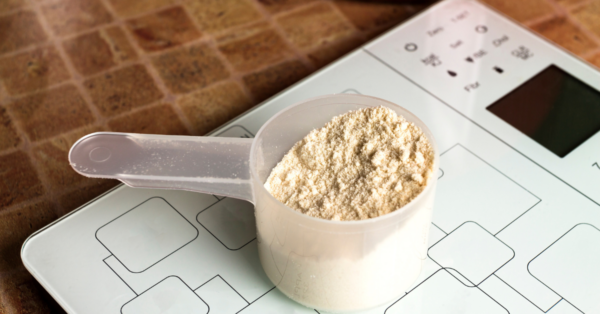Lactobacillus casei is a rod-shaped, gram-positive, non-spore forming bacterium strain in the Lactobacilli genus (1).
It is found in many strains in lactic acid fermented food products such as sauerkraut, fermented meat and fish, sourdough, pickled vegetables, and wine as well as in beets and dairy products such as Mozzarella cheese (1,2).
The bacterium Lactobacillus casei cannot tolerate temperatures above 45 degrees Celsius, but can tolerate a wide range of pH values, including environments with a pH below 3.0 (1). Due to its tolerance of such acidic environments, as well as those containing bile salts, it can easily survive in the human gastrointestinal tract (2,3).
Lactobacillus casei strains are commonly used as probiotics to help control the immune response and to assist in positively altering the composition of the gut microbiome (4).
Research has found that the genomic content of various strains of Lactobacillus casei can very as much as 32 to 45-percent.
Origins & Functions
The genotyping of Lactobacillus casei strains has been studied through Multilocus Sequence Typing (MLST) and has been diverged into three major lineages, L. casei, L. paracasei, and L. rhamnosus, dating back to 1.5 million years ago (3,4).
Lactobacillus casei has been isolated from a variety of hosts such as plants, human and animal body cavities (i.e the gastrointestinal tract, vagina, and oral cavities), as well as a variety of foods such as meat, fish, potatoes, cheese, pickles, wine, and fermented dairy products (1,3,4).
The functions of Lactobacillus casei and related strains in this species are very specific to each strain and include:
- Anti-inflammatory functions (3).
- Immune modulation through the decrease of expression of the pro-inflammatory cytokine TNF-α, and interferon receptors 1 and 2 (IFNar1 and IFNar2) (4). This is significant since cytokines are hormone-like proteins made by cells that help to regulate the immune system (5). Furthermore, interferon receptors are required for interferons, which is a type of cytokine, to bring about inflammatory responses in cells (4,6).
- Positive and negative modulation of gene expression of those genes involved in control of the cell cycle as well as the regulation of expression of those genes involved in the inhibition of apoptosis, or cell death, and genes involved in the ubiquitination/degradation of proteins (7).
Commercially, Lactobacillus casei began its use as a probiotic in Japan in the 1930s and is now widely used globally as a probiotic to help those with various digestive conditions (8,9).
Furthermore, Lactobacillus casei and Lactobacillus paracasei has been used as a starter culture in the fermentation of milk products and to help develop flavor in bacterial-ripened cheeses.
Potential Health Benefits
Lactobacillus casei is a widely studied bacterium and has been linked with a variety of health benefits.
Its ability to survive acidic environments makes it a viable bacterium for use in helping improve the composition of the gut microflora.
L. casei, as well as its other lineages, L. rhamnosus and L. paracasei, have been shown to have anti-inflammatory, immune-enhancing, and pain-reducing properties in bone, neurological, and digestive conditions.
Listed below are examples of the diverse range of applications that Lactobacillus casei and its lineages have in the treatment of many aspects of health.
Arthritis and Related Conditions
Arthritis is a common condition that encompasses various joint diseases such as osteoarthritis, which is the most common form, as well as the inflammatory arthritic conditions rheumatoid and psoriatic arthritis (10).
Common symptoms of osteoarthritis include swelling pain, stiffness, and decreased range of motion, while uncontrolled inflammation, possible joint erosion, and organ damage is associated with the inflammatory arthritic conditions.
Aging, poor diet, stress, and smoking are risk factors for arthritis, which is not surprising since these factors can induce pro-inflammatory oxidative stress in the body (10,11). This in turn can increase risk of cell damage and disease.
Research is showing that gut bacteria may be related to the inflammation involved in arthritic conditions.
One study found that 75-percent of people that had newly onset, untreated rheumatoid arthritis and 38-percent of people with newly onset psoriatic arthritis had the bacterium Prevotella copri in their gut (11). This is compared to 21-percent in the control group and 12-percent in the chronic, treated rheumatoid arthritis group.
An animal study found that inflammation was induced in those mice treated with Prevotella copri, which suggests that there may be a link between this bacterium and inflammatory arthritis, although further research is warranted.
This study, along with other research showing that arthritis risk factors may be linked to gut imbalances, suggests that arthritis may have a gut health component to it, and therefore may be treated with probiotics as an adjunct therapy for alleviation of symptoms (11,12).
The probiotic strain Lactobacillus casei Shirota (LcS) was studied for its use in treatment of individuals with osteoarthritis (13).
This double-blind, placebo-controlled study involved 537 patients with knee osteoarthritis who were given skimmed milk daily with either LcS or placebo for six months. Those individuals that consumed the LcS had significantly improved Western Ontario and McMaster Universities Osteoarthritis Index (WOMAC) and Visual Analog Scale (VAS) scores.
This improvement can be interpreted as significantly lower levels of the inflammatory marker C-reactive protein (CRP), reductions in pain, stiffness, physical function, and well-being index scores.
Another study looked at the impact of Lactobacillus casei 01 on rheumatoid arthritis (RA) symptoms in women (14). Those who received the Lactobacillus casei 01 supplementation had reduced CRP levels as well as lower swollen and tender joint counts.
Another study of women found that those who received a capsule of 108 CFU (colony-forming units) of Lactobacillus casei had a reduction in swollen and tender joint counts than those in the control group (15).
These studies confirm earlier findings from animal studies for the potential of Lactobacillus casei to reduce RA symptoms.
Immune Modulation in Infections
Although the potential benefits of probiotics in the strengthening of the immune function is greater in those with weakened immune systems, research is showing that many others could still benefit.
One study looked at the effect of Lactobacillus casei Shirota on highly-active athletes that had upper respiratory-tract infection (URTI) (16).
For 16 weeks, 84 individuals were either given a placebo or Lactobacillus casei Shirota probiotic capsules daily. Blood and saliva samples taken at 8 and 16 weeks found that although the severity and duration of URTI symptoms was similar between the treatment groups, those who were given the probiotic treatment had a significantly lower number of URTI episodes than those in the placebo group.
Another study looked at the impact of heat-killed Lactobacillus casei DK128 on mice infected with the influenza A virus primary infection (17). Researchers found that those mice pre-treated with the bacterium strain were protected against the influenza virus infection independent of strain due to the strain lessening weight loss, and in turn reducing morbidity.
This study suggests that further study on this heat-killed strain in this application may provide an alternative treatment against non-specific influenza virus infections in humans.
Digestive Conditions
The antioxidant and anti-inflammatory properties of Lactobacillus casei have been found to be effective as an adjunct treatment for inflammatory bowel disease and other digestive conditions.
The two most common forms of inflammatory bowel disease (IBD) are Crohn’s disease and ulcerative colitis (18). They both involve ongoing inflammation of all or parts of the digestive tract that causes symptoms such as persistent diarrhea, abdominal pain, rectal bleeding, weight loss, and fatigue.
Typical treatments involve biologics like corticosteroids or immunomodulators.
However, research is showing that probiotics may be an adjunct therapy for treatment of inflammatory bowel diseases.
One study looked at the impact of Lactobacillus casei Lbs2 on a mouse model of IBD (19).
Study results show that both live and heat-killed Lactobacillus casei Lbs2 (MTCC5953) significantly suppressed the secretion of pro-inflammatory cytokines tumor necrosis factor-alpha (TNF-alpha) and interleukin-6. This shows that this bacterium strain may be a possible candidate for a future IBD therapy.
Another mouse model looked at the effect of a treatment of lysates, or killed version, of the bacterium Lactobacillus casei DN-114 001 (Lc) on colitis (20). Study results show that the bacterium increased numbers of CD4(+) FoxP3(+) cells, which are a type of white blood cell important for the immune system. In addition, the bacterium helped to decrease the production of the pro-inflammatory cytokines TNF-alpha and Interferon-gamma.
Therefore, these results reveal potential for even killed bacterium to prevent intestinal inflammation by strengthening the intestinal barrier and modulating the gut microbiome.
There is also promise for treatment of Crohn’s disease with the Lactobacillus casei bacterium. An animal study looked at the effect of Lactobacillus casei BL23 strains on mice with Crohn’s disease (21).
The study found that the mice receiving these engineered strains of Lactobacillus casei had a faster recovery of initial weight loss from their illness, reduced inflammation in the gut, and increased enzymatic activities in the gut.
Furthermore, a study was performed on the impact of Lactobacillus casei DN-114 001 on human ileal specimens, or cells from the part of the small intestine that opens into the colon (22).
The cells were exposed to either Lactobacillus casei DN-114 001 or Escherichia coli ATCC 35345, or both.
The study results show that the Lactobacillus casei treated cells had a reduction in TNF-alpha, interferon-gamma (IFN-gamma), and interleukins 2, 6, and 8.
A reduction in these cytokines show that Lactobacillus casei DN-114 001 may be effective in counteracting the proinflammatory effects of Escherichia coli ATCC 35345 on mucosal cells inflamed by Crohn’s disease.
Other potential health benefits being examined:
Obesity
Recent research suggests that obesity may be associated with structural and composition differences in the gut microbiome as compared with non-obese states.
A 2015 study looked at the effect of Lactobacillus casei Shirota on high fat diet-induced obese rats (23). Study results show that LcS supplementation daily over 15 weeks produced a reduction in body fat mass and the pro-inflammatory cytokine interleukin-6 as compared to the weight loss medication Orlistat.
A more recent study looked at the effect of LcS on obesity in children (24).
A group of obese children were placed on a diet and exercise program for 6 months, then for another 6 months were given an LcS beverage daily. Study results show that after the 6-month period of LcS ingestion, there was a significant loss of body weight and increase in “good” high-density lipoprotein (HDL) cholesterol as compared to the baseline taken at the start of the LcS study period.
These studies show potential for LcS as a therapy option for obese individuals upon further confirmational studies over longer periods of time.
Migraines
A 2017 study review looked at the effects of probiotics on migraine symptom improvement (25).
One study reviewed the effect of a probiotic product on migraine sufferers.
The probiotic product contained Bifidobacterium bifidum W23, Bifidobacterium lactis W52, Lactobacillus acidophilus W37, Lactobacillus brevis W63, Lactobacillus salivarius W24, Lactococcus lactis W19, Lactococcus lactis W58, and Lactobacillus casei W56.
After 12 weeks of treatment, 67-percent of study participants reported a decrease in the number of migraine days. This study warrants the need for randomized controlled trials of such probiotic products in the treatment of migraine headache patients.
Liver Disease
A 2011 study of patients with alcoholic cirrhosis, a type of liver disease, looked at the impact of LcS treatment on their condition.
The patients were treated with LcS three times daily for four weeks, and this helped to normalize the levels of neutrophil phagocytic activity and toll-like receptor 4 (TLR4) as compared to a baseline level of lower than normal neutrophils and higher TLR4 (9). A reduction in neutrophils can increase inflammatory status in the body, while TLRs are in charge of sensing pathogens.
These results suggest that LcS may be able to reduce inflammation in those with alcoholic cirrhosis.
Aflatoxin Treatment
Aflatoxins are a highly toxic metabolite produced by fungal species such as Aspergillus flavus, Aspergillus parasiticus, and Aspergillus nomius that usually infect crops such as wheat, walnut, corn, peanuts, tree nuts, and cotton (26).
Some aflatoxins are heat-resistant and therefore cannot be destroyed with cooking. Infection with aflatoxins can cause complications such as toxicity of the liver or immune system and can produce an increased inflammatory response.
A randomized, double-blind, cross over, placebo-controlled study of LcS looked at its impact on aflatoxin biomarkers in humans (27).
Subjects received a fermented milk drink containing LcS, while others received placebo drinks. In one of the treatment groups, the serum aflatoxin B1-lysine adduct, which is a molecular dosimeter for assessment of aflatoxin exposure, was significantly lower at 2 weeks as compared to baseline and was also significantly lower than the placebo group at 4 weeks post-treatment.
This study warrants further research on the effects of LcS treatment on potential prevention of dietary aflatoxin exposure.
Form of taking it
Besides being consumed in the form of fermented food products, Lactobacillus casei can also be consumed in the form of a powder added to food or drink items or swallowed in a capsule or tablet form.
In clinical environments, as studies have shown, Lactobacillus casei can be incorporated into other treatment modalities such as fermented beverages and milk products such as cow’s milk and soy milk (28).
Possible side effects
The Lactobacillus casei Shirota and 431 strains have been designated as Generally Recognized as Safe (GRAS) by the United States Food and Drug Administration(FDA) (29,30).
They are considered safe for human consumption in food products and dietary supplements, and no reports of serious adverse effects of the bacterium have been made.
Lactobacillus casei 431, also identified as Lactobacillus paracasei subsp. paracasei, has been used in food and dietary supplements since 1995, and Lactobacillus paracasei has been granted New Dietary Ingredient (NDI) by the FDA and Qualified Presumption of Safety (QPS) status since 2007 by the European Food Safety Authority (29).
Meanwhile, Lactobacillus casei Shirota (LcS) has been safely consumed in such forms as Yakult fermented milk product since 1935 (30).
It has been given the Food for Specified Health Uses (FOSHU) label in Japan, which signifies products whose safety and health benefits have been scientifically proven.
Furthermore, Lactobacillus casei subsp. rhamnosus strain GG has been designated GRAS status for use as in an infant formula product, while Lactobacilli bacterium in general have been largely regarded as safe (31,32).
Research on critically ill children in intensive care has found LcS treatment to be safe for such individuals with no evidence of colonization or bacteremia in those treated (33). However, it is important to note that those with compromised immune systems, short bowel syndrome, central venous catheters, elderly patients, those with cardiac valve disease, as well as premature infants, may be at higher risk for adverse effects from probiotic treatment and should be monitored closely (32).
What to look for when buying
Before buying a product containing Lactobacillus casei, check the label carefully.
A third-party verification for safety and quality can reassure you that the probiotic you are purchasing is what the label says it is (34).
Some unverified probiotic supplements may be full of fillers or may contain less of a concentration of bacterium than what is stated on the label since supplements are not required to be approved by the Food and Drug Administration (35). Unfortunately, some companies use this to their advantage and market products falsely to deceive consumers and make money off weak and ineffective products.
Also, consuming probiotic-rich foods in their purist form can provide you with an unadulterated dose of Lactobacillus casei.
[expand title=”References:”]
- University of California, Davis (March 16, 2017) “Lactobacillus casei.” Viticulture & Enology. http://wineserver.ucdavis.edu/industry/enology/winemicro/winebacteria/lactobacillus_casei.html
- de Souza, B.M.S., Borgonovi, T.F., Casarotti, S.N. et al. Probiotics & Antimicro. Prot. (2018). https://doi.org/10.1007/s12602-018-9406-y
- Douillard, F.P., et al. (2013) “Comparative genome analysis of Lactobacillus casei strains isolated from Actimel and Yakult products reveals marked similarities and points to a common origin.” Microbial Biotechnology, 6(5): 576-587. https://www.ncbi.nlm.nih.gov/pubmed/23815335
- Aktas, B., De Wolfe, T.J., Safdar, N., Darien, B.J., and Steele, J.L. (2016) “The Impact of Lactobacillus casei on the Composition of the Cecal Microbiota and Innate Immune System Is Strain Specific.” PLoS ONE, 11(5): e0156374. https://www.ncbi.nlm.nih.gov/pubmed/27244133
- DANISCO (accessed June 1, 2018) “Lactobacillus plantarum Lp-115.” Technical Memorandum.
- Encyclopedia Britannica Online (accessed June 18, 2018) “Interferon.” https://www.britannica.com/science/interferon
- Tien, M-T., et al. (2006) “Anti-Inflammatory Effect of Lactobacillus casei on Shigella-Infected Human Intestinal Epithelial Cells.” The Journal of immunology, 176: 1228-1237. https://www.ncbi.nlm.nih.gov/pubmed/16394013
- Toh, H., et al. (October 2013) “Genomic Adaptation of the Lactobacillus casei Group.” PLoS ONE, 8(10): e75073. https://www.ncbi.nlm.nih.gov/pubmed/24116025
- Hakansson, A. and Molin, G. (2011) “Gut Microbiota and Inflammation.” Nutrients, 3: 637-682. https://www.ncbi.nlm.nih.gov/pmc/articles/PMC3257638/
- Arthritis Foundation (accessed June 20, 2018) “What Is Arthritis?” https://www.arthritis.org/about-arthritis/understanding-arthritis/what-is-arthritis.php
- Torgan, Ph.D., C. (November 25, 2013) “Gut Microbes Linked to Rheumatoid Arthritis.” https://www.nih.gov/news-events/nih-research-matters/gut-microbes-linked-rheumatoid-arthritis
- Li, Y., Luo, W., Deng, Z., and Lei, G. (2016) “Diet-Intestinal Microbiota Axis in Osteoarthritis: A Possible Role.” Hindawi Publishing Corporation, Volume 2016, Article ID 3495173, 4 pages. https://www.ncbi.nlm.nih.gov/m/pubmed/27610004/
- Lei, M., Guo, C., Wang, D., Zhang, C., and Hua, L. (October 2017) “The effect of probiotic Lactobacillus casei Shirota on knee osteoarthritis: a randomized double-blind, placebo-controlled clinical trial.” Beneficial Microbes, 8(5): 697-703. https://www.ncbi.nlm.nih.gov/pubmed/28726510
- Alipour, B., et al. (June 2014) “Effects of Lactobacillus casei supplementation on disease activity and inflammatory cytokines in rheumatoid arthritis patients: a randomized double-blind clinical trial.” International Journal of Rheumatic Diseases, 17(5): 519-527. https://www.ncbi.nlm.nih.gov/pubmed/24673738
- Diamanti, A.P., Rosado, M.M., Laganá, B., and D’Amelio, R. (2016) “Microbiota and chronic inflammatory arthritis: an interwoven link.” Journal of Translational Medicine, 14:233. https://www.ncbi.nlm.nih.gov/pmc/articles/PMC4973033/
- Gleeson, M., Bishop, N.C., Oliveria, M., and Tauler, P. (2011) “Daily Probiotic’s (Lactobacillus casei Shirota) Reduction of infection Incidence in Athletes.” International Journal of Sport Nutrition and Exercise Metabolism, 21, 2011, 55-64. https://www.ncbi.nlm.nih.gov/pubmed/21411836
- Jung, Y-J., et al. (2017) “Heat-killed Lactobacillus casei confers broad protection against influzena A virus primary infection and develops heterosubtypic immunity against future secondary infection.” Scientific Reports, 7: 17360. https://www.semanticscholar.org/paper/Heat-killed-Lactobacillus-casei-confers-broad-A-and-Jung-Lee/df2af0ad609402b766b341c0bae4bfdaf92f8065
- Centers for Disease Control and Prevention (March 22, 2018) “What is inflammatory bowel disease (IBD)?” https://www.cdc.gov/ibd/what-is-IBD.htm
- Thakur, B.K., et al. (July 2016) “Live and heat-killed probiotic Lactobacillus casei Lbs2 protects from experimental colitis through Toll-like receptor 2-dependent induction of the T-regulatory response.” International Immunopharmacology, 36:39-50. https://www.ncbi.nlm.nih.gov/pubmed/27107798
- Zakostelska, Z., et al. (2011) “Lysate of probiotic Lactobacillus casei DN-114 001 ameliorates colitis by strengthening the gut barrier function and changing the gut microenvironment.” PLoS ONE, 6(11): e27961. https://www.ncbi.nlm.nih.gov/pubmed/22132181
- Wang, Y., et al. (2017) “Antioxidant Properties of Probiotic Bacteria.” Nutrients, 9:521. https://www.ncbi.nlm.nih.gov/pmc/articles/PMC5452251/
- Borruel, M.D., N., et al. (February 2009) “Lactobacillus casei Downregulates Commensals’ Inflammatory Signals in Crohn’s Disease Mucosa.” Inflammatory Bowel Diseases, 15(2): 275-283. https://www.ncbi.nlm.nih.gov/pubmed/18839424
- Karimi, G., et al. (2015) “The anti-obesity effects of Lactobacillus casei strain Shirota versus Orlistat on high fat diet-induced obese rats.” Food & Nutrition Research, 59: 10.3402/fnr.v59.29273. https://www.ncbi.nlm.nih.gov/pubmed/26699936
- Nagata, S., Chiba, Y., Wang, C., and Yamashiro, Y. (August 2017) “The effects of the Lactobacillus casei strain on obesity in children: a pilot study.” Beneficial Microbes, 8(4): 535-543. https://www.ncbi.nlm.nih.gov/pubmed/28618860
- Dai, M.D., Y-J., Wang, M.D., H-Y., Wang, M.D., X-J., Kaye, M.D., A.D., and Sun, M.D., Y-H. (2017) “Potential Beneficial Effects of Probiotics on Human Migraine Headache: A Literature Review.” Pain Physician, 20: E251-E255. https://www.ncbi.nlm.nih.gov/pubmed/28158162
- Kumar, P., Mahato, D.K., Kamle, M., Mohanta, T.K., and Kang, S.G. (January 2017) “Aflatoxins: A Global Concern for Food Safety, Human Health and Their Management.” Frontiers in Microbiology, Volume 7, Article 2170. https://www.ncbi.nlm.nih.gov/pubmed/28144235
- Redzwan, S.M., et al. (January 2016) “Effect of supplementation of fermented milk drink containing probiotic Lactobacillus casei Shirota on the concentrations of aflatoxin biomarkers among employees of Universiti Putra Malaysia: a randomized, double-blind, cross-over, placebo-controlled study.” British Journal of Nutrition, 115(1): 39-54. https://www.ncbi.nlm.nih.gov/pubmed/26490018
- Wang, J., et al. (June 2009) “Fermentation characteristics and transit tolerance of probiotic Lactobacillus casei Zhang in soymilk and bovine milk during storage.” Journal of Dairy Science, 92(6): 2468-2476. https://www.ncbi.nlm.nih.gov/pubmed/19447978
- CHR Hansen (accessed June 20, 2018) “Lactobacillus (L. CASEI 431®).” https://www.chr-hansen.com/en/probiotic-supplements-and-infant-formula/cards/product-cards/lactobacillus-paracasei-subsp-paracasei-l-casei-431
- Yakult (accessed June 20, 2018) “LcS Good Bacteria.” https://www.yakult.co.in/yakult-LCS.php
- Food and Drug Administration (May 29, 2008) “Agency Response Letter GRAS Notice No. GRN 000231.” https://wayback.archive-it.org/7993/20171031031604/https://www.fda.gov/Food/IngredientsPackagingLabeling/GRAS/NoticeInventory/ucm153907.htm
- Snydman, D.R. (2008) “The Safety of Probiotics.” Clinical Infectious Diseases, 46: S104-S111. https://www.ncbi.nlm.nih.gov/pubmed/18181712
- Srinivasan, R., Meyer, R., Padmanabhan, R., and Britto, J. (February 2006) “Clinical Safety of Lactobacillus casei shirota as a Probiotic in Critically Ill Children.” Journal of Pediatric Gastroenterology and Nutrition, 42(2): 171-173. https://www.ncbi.nlm.nih.gov/pubmed/16456410
- Sanders, M.E., et al. (November-December 2016) “Probiotic use in at-risk populations.” Journal of the American Pharmacists Association, 56(6): 680-686. https://www.sciencedirect.com/science/article/pii/S1544319116307324
- Harvard Health Publishing (February 2018) “The growing role of probiotics.” https://www.health.harvard.edu/staying-healthy/the-growing-role-of-probiotics








